A. J. Stevens &
Company (1914) Limited - The early years.
| Due to the lack of space in the Retreat
Street works, and the growing demand for A.J.S. products,
the Stevens brothers urgently needed larger premises in
order to increase production. In order to finance the new
venture, the brothers formed a new public company called A.
J. Stevens & Company (1914) Limited, on 18th July, 1914,
with a nominal share capital of £50,000. The directors were
George Stevens, Harry Stevens, Jack Stevens, Joe Stevens
junior, E. E. Lamb (stockbroker), and E. L. Morcom
(engineer). The registered office was in Retreat Street. |
|
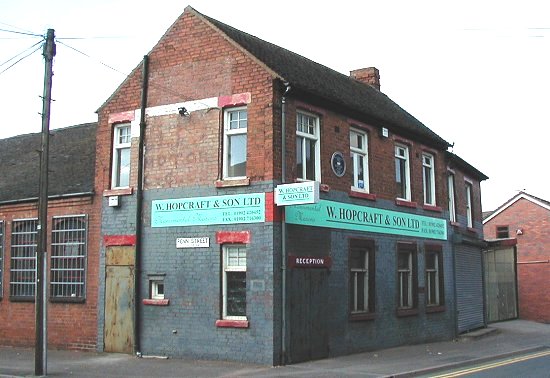
The Retreat Street offices and
factory, as seen in 2002. |
The brothers didn’t have to look far
for new premises, the solution lay close at hand.
Round the
corner from Retreat Street, near Penn Road, stood Graiseley
House, a large Victorian dwelling with around 10.5 acres of
land.
The owner of the estate, Richard Evans Willoughby Berrington,
a civil engineer, wanted to emigrate to Australia, and so he
put his estate up for sale. |
|
The brothers quickly purchased the
Graiseley Hill estate, and work soon began on the first
factory building, measuring 260 feet x 80 feet.
The model 'D' combination continued to
be as popular as ever.
An updated version with easily
interchangeable wheels and a fully sprung, luxurious sidecar
with leather upholstery, was launched. |

Another view of the Retreat Street premises. The
building on the right was a house, then a shop, purchased by Stevens Brothers Limited in the 1940s as an extension
to the site. |
|
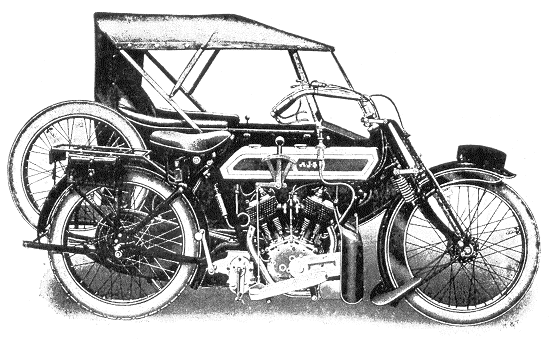
The 1914 model 'D' combination. Courtesy of the
late Jim Boulton. |
Late 1914 was a busy time for everyone at the works.
The factory staff worked flat-out to fulfil orders, plans
were being made for the next phase of the development at
Graiseley Hill, and new motorcycles were designed in
readiness for 1915. |
|
The wedding of Lily Stevens to Jabez Wood in 1914.
The photograph
is taken outside the Retreat Street works.
Photo courtesy of the late Geoff Stevens. |
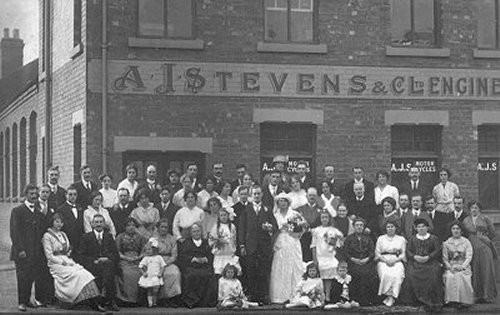 |

Joe Stevens junior and his wife Lucy in their 6h.p. model 'D'
passenger outfit at Old Wyche Cutting Near Malvern. They were
taking part in a reliability trial in 1915.
Photo courtesy of the late Geoff Stevens. |
The new motorcycles had an improved
frame, with a wedge shaped petrol tank, and very wide front
mudguards. The range included a new model ‘A’, a 4hp. V twin
design that could be purchased as a solo machine, or a
combination, with a specially designed sidecar. The solo
machine sold for 66 guineas, and the combination sold for 81
guineas.
The 6hp. model ‘D’ remained unchanged
and sold for 72 guineas. The combination sold for 88
guineas. A Lucas dynamo-driven electric light was also
available for an extra 14 guineas.
|
|
The 2¾hp. model ‘B’ was available in
two versions, a touring model, or a sporting model, both
with a 2 or 3 speed gearbox. Two speed models sold for 47
guineas, and 3 speed models sold for 50 guineas.
Due to the war, the annual November
Olympia Show had been cancelled, and so the new machines
were promoted in a special exhibition in the showroom of the
London based agents, H. Taylor & Company Limited.
The first factory building at Graiseley
Hill soon reached completion, and production moved from
Retreat Street to Graiseley Hill. The Retreat Street
premises continued in use as the office and repair
department. |
|

Graiseley House, around which the new
factory was built. |
|
Because of wartime shortages of
material and manpower, the model ‘B’ was discontinued. Many
things were in short supply including petrol.
In 1916 petrol became very scarce and extremely expensive,
due to the war. A.J.S. being as inventive as ever, decided to
use town gas in the Engine Test House, instead of petrol. A
large gas supply pipe ran along the back of the test bench, and
small branch pipes fed the gas directly into the engines. At the
induction pipe entrance a bunsen burner attachment was fitted so
that the quality of the mixture could be adjusted when
necessary. The speed could be varied by turning the gas on or
off at the supply.
Initially the gas was fed directly into an ordinary
carburettor, which worked satisfactorily, but was not as convenient as
the final arrangement. The engines showed no signs of overheating and
ran perfectly regularly, although the speed and performance were not
quite as good as when using petrol.
|
|
The Engine Test House in 1916 with the gas supply in
use. |
 |
|
In the middle of 1916 Jack Stevens
contracted polio after getting wet during a shooting trip.
From then-on he could only walk with the aid of sticks.
On 3rd November, 1916 the
Ministry of Munitions prohibited the manufacture of
motorcycles for the civilian market, only military
motorcycles could then be produced. |
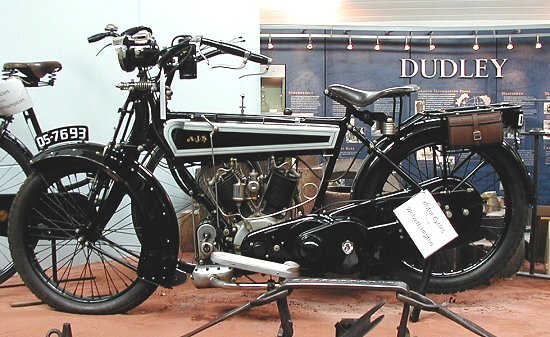
The 1916 A.J.S. 4hp. Model 'A' that's on
display at the Black Country Living Museum, Dudley. |
In 1917 the office and repair
department moved to Graiseley Hill. The old Retreat Street
buildings were handed over to the Stephens Screw Company
Limited for additional workshop space.
Luckily for A.J.S. the Ministry of
Munitions received a large order for motorcycles for the
Russian army. The order included machine gun carriers,
ammunition carriers and light ambulances. |
| The ministry sub-contracted the order to a number of
motorcycle manufacturers including A.J.S. As a result A.J.S.
produced 1,100 military machines, all 6hp. models with many
of the existing A.J.S. features, including
the desirable easily interchangeable wheels. Hostilities finally ceased on 11th
November, 1918, and in January 1919 the restrictions on
civilian motorcycle production were lifted. Building work at
Graiseley Hill restarted with the building of three factory
buildings, each measuring 260 feet x 80 feet.
They each had the same floor area as the original factory
building completed in 1915, but were 1 foot higher, to allow for more
head room in the workshop. Graiseley
House was properly converted for office use, and the
original factory building converted into the machine
shop. Before the year was out the works covered 109,586 square feet. |
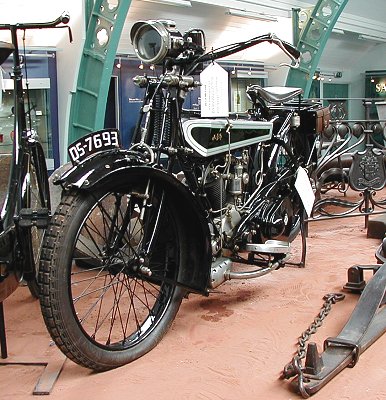
Another view of the Model 'A'
at the Black Country Living Museum, Dudley. |
|
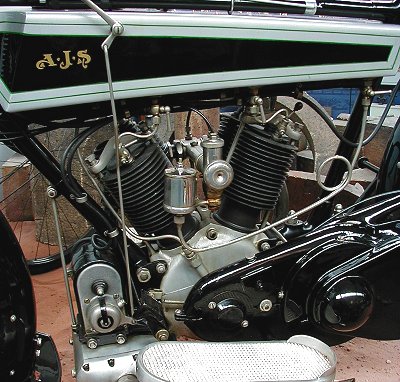
A close-up of the model 'A'
and the 550c.c. V twin engine. |
The buildings were arranged so that
everything moved through the factory in an orderly fashion,
starting at the receiving and issuing stores on Graiseley
Hill at the northern end of the site, to the despatch and
repair departments at the southern end of the site, off
Marston Road.
The large general receiving stores had
a basement containing the steel stores, where everything was
arranged on racks, then numbered and listed for issue to the
works.
The smallest section carried was
¼inch round steel rod, used for gearbox
push rods. The largest diameter stocked, 3 inches round, was
also used for gearbox work, and machined into lay
shafts and gears.
Graiseley Hill which originally extended
from Penn Road as far as the main gates was extended, with a
downwards slope for direct access to the steel
stores.
|
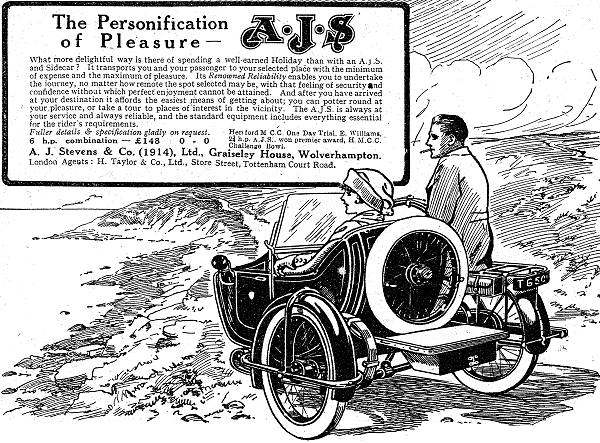
An advert for the A.J.S. combination, from 'The Motor Cycle' magazine, 4th
September 1919. Courtesy of the late Jim Boulton. |
|
The machine and fitting shops
both had a large number of clever jigs and gauges which were
perfected by Jack Stevens.
Each of
the four brothers had an exclusive role at Graiseley Hill.
Harry, the eldest worked on design, particularly engines,
and special purpose machinery. George took charge of the
commercial and sales side, being largely responsible for
the extensive export business. Joe junior was in charge of
production, and oversaw the racing and competition side of
the business. Jack was in charge of the drawing office and
design.
|
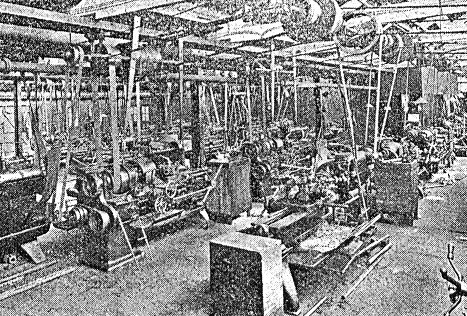 The turret and capstan section of
the machine shop in 1920.
The turret and capstan section of
the machine shop in 1920. |
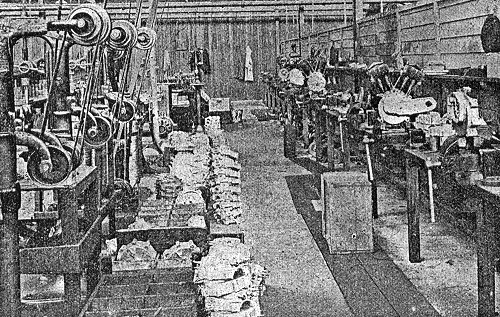 The engine erecting shop in 1920.
The engine erecting shop in 1920.
|
The fifth
and youngest brother, William, born in 1893, forever known
as 'Young Billy' was not a director of A.J.S.
Initially he
had little to do with the company, working instead in the
Stevens Screw Company Limited with his father and sisters.
At the onset of World War One he joined-up as a despatch
rider and saw service in the Dardanelles during the
Gallipoli campaign, and Salonika on the Western Front.
|
| On his return from the war,
Joseph Stevens senior made him a director of the Stevens
Screw Company, whilst his brothers offered him a managerial
position at Graiseley Hill, looking after the spares
department and the export department. He is well remembered
for the excellent motorcycle spares manuals that he
prepared. |
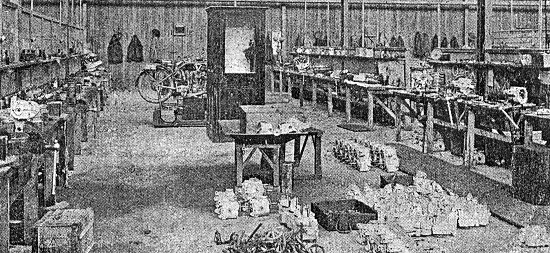 The gearbox fitting shop in 1920.
The gearbox fitting shop in 1920.
|
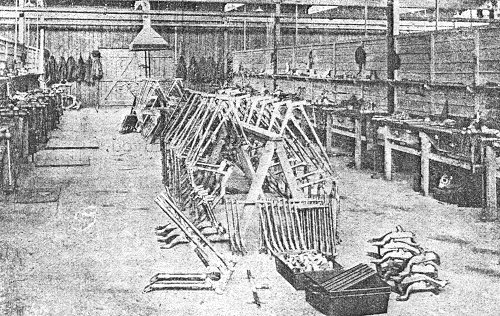 The frame building department in
1920.
The frame building department in
1920. |
The latest types of machines were installed, all driven
from overhead line shafting.
A.J.S. used more modern machinery than any other local
vehicle manufacturer at the time.
Everything was made to a close tolerance, and any spare
part could be quickly installed, just as we do today. |
| This wasn't true for other local makes. At the
neighbouring Sunbeam factory, everything was fitted by hand,
and filed to size, so that many spare parts required careful
fitting, often involved filing to size, or drilling
appropriately sized holes. |
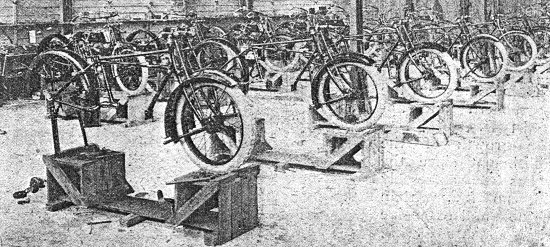 The assembly department in 1920.
The assembly department in 1920. |
|
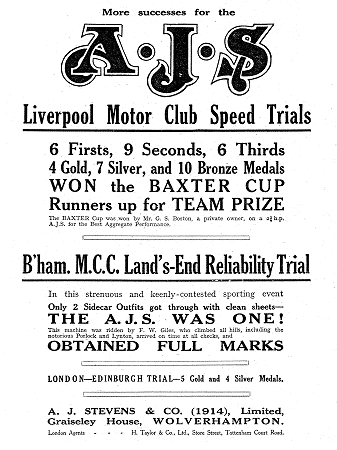
From 'The Motor Cycle', 10th June, 1920.
|
A new version of the 6hp. model 'D'
combination called
the 'de-luxe' was quickly produced, featuring a new style
petrol tank, a rear stand, a quiet running engine with a
cast aluminium silencer, quickly interchangeable wheels, and
detachable cylinder heads.
The sidecar was more
luxurious than ever with full weather protection consisting of a
folding hood and cover, side curtains and a storm proof apron.
It
also had a luggage grid, a tool locker and a spare wheel that was
interchangeable with those on the motorcycle.
Around 65 of the new machines were built each
week. Due to inflation prices varied from 135 guineas to 190
guineas.
The machine featured on the company's
display stand at the November 1919 Olympia Show, which
returned after an absence of 5 years.
|
1920 saw the reappearance of the Isle of Man T.T. and so A.J.S. decided
to try and repeat the success that it had in the 1914 Junior T. T.
Harry
developed a new 2¾hp. overhead valve
engine for the T.T. machine, which included a 3-speed countershaft
gearbox, to provide 6 speeds by engaging either of 2 engine sprockets.
It had a Thompson-Bennett magneto and an Amac carburettor.
A.J.S. were very lucky to acquire the services of Howard Davies, who
would go on to become a famous rider, and motorcycle manufacturer in his
own right.
| Read about Howard Davies |
 |
|
 |
| The works team consisted of Cyril Williams, Eric Williams, Howard
Davies, Ossie Wade, H. F. Harris, and Tom Sheard. H. V. Prescott.
privately entered his A.J.S machine. Howard Davies also entered the
Senior event. |

The machines on route to Liverpool for the 1920 Isle of
Man T.T. Courtesy of the late Jim Boulton. |
| Read about the new T.T.
machines |
 |
|
The only member of the works team to finish was Cyril
Williams. He led the race by over 15 minutes, until four miles from the
end when he experienced problems with the gear change. He ended-up
pushing his machine to the finishing post, and still managed to win by
over nine minutes. It was a great triumph for A.J.S.
Although the new engine developed around 40%
more power than earlier versions, the mainshafts and
crankshaft had not been sufficiently strengthened, and so
were prone to breakages.
On 19th October Howard Davies took an experimental 2¾hp.
overhead valve machine and sidecar to Brooklands and set a series of
outstanding records, both for a solo machine, and a
combination. He broke 14 records and became the first rider to achieve 80m.p.h. on a 2¾hp. machine.
The flying kilometre and mile records are as follows:
| Class
B. For 350c.c. solo motorcycles: |
| Flying kilometre |
27.87 seconds |
80.94m.p.h. |
| Flying mile |
47.4 seconds |
75.95m.p.h. |
| Average
mean speed record: |
| Flying kilometre |
29.9 seconds |
77.4m.p.h. |
| Flying mile |
49.1 seconds |
73.32m.p.h. |
| Class
F, G, & H with sidecar. 350c.c., 500c.c.,
750c.c.: |
| Flying kilometre |
33.2 seconds |
67.38m.p.h. |
| Flying mile |
55.2 seconds |
65.22m.p.h. |
In 1920 A.J.S. took over Charles Hayward's sidecar company and purchased
the Stewart Street factory. The company still continued to trade as C.
W. Hayward, with Charles as Managing Director.
|
|
|
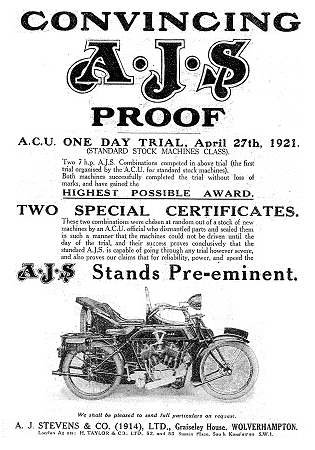
From 'The Motor Cycle', 5th May, 1921. |
In 1921 a new 7h.p. version of the
model 'D' was introduced and exhibited at Olympia in November. The
motorcycle on its own initially sold for £159.10s.0d. or £215 with a
sidecar, but prices varied due to high levels of inflation.
Sales
reached an all time high and so the factory was further extended in
order to increase production. Another new machine was the '2¾hp.
Lightweight Solo' with 3-speeds, kick starter, quick detachable rear
wheel, and a low and comfortable riding position. It sold for £95.
Early in the year a prototype three wheel car was produced with two
wheels at the front and one at the rear. Although the design
showed some promise, it never went into
production.
The model 'B' was reintroduced in March using a
2¾hp. side valve engine, to
satisfy the large number of requests for such a machine,
following the company's success in the T.T.
Listed as a touring machine, it incorporated many new
features, including a 3-speed gearbox, chain drive, Amac
carburettor, and Lucas Magneto. It sold for £95. |
| The company had another
successful racing and trials year. Work had begun on an improved 2¾hp.
T.T. machine back in the summer of 1920.
The new machine performed
extremely well and captured four Class B long distance records at
Brooklands on 24th May, 1921. Ridden by Howard Davies.
The records were as follows:
| Class B.
350c.c. |
| 100 miles |
1h 32m 45.6sec. |
64.68m.p.h. |
| 50 miles |
45m 6.8 sec. |
66.49m.p.h. |
| Two hours |
130 miles 1054yds |
65.3m.p.h. |
| One hour |
66 miles 162yds |
66.09m.p.h. |
|
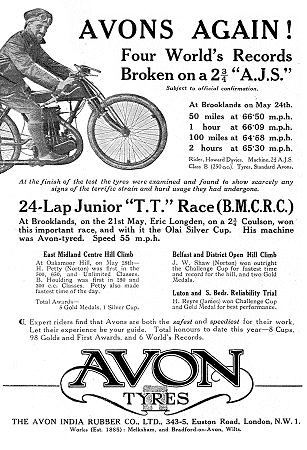
From 'Motor Cycling' 15th June, 1921.
|
|
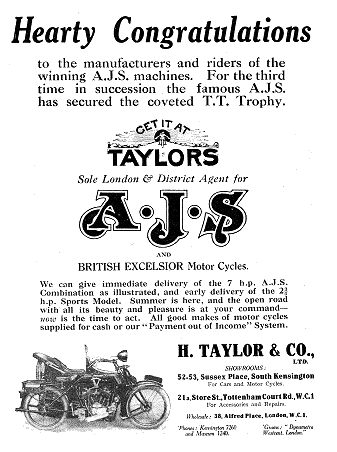
From 'The Motor Cycle' 23rd June, 1921. |
The A.J.S. team for the Junior T.T. in May consisted of
Eric Williams, Howard Davies, H. F. Harris, Tom Sheard, Ossie Wade,
George Kelly, and V. Olsson.
Yet again it was a triumphant year for the
company. Eric Williams finished in 1st place at an average speed of
52.21m.p.h., Howard Davies came in 2nd, Tom Sheard 3rd, George Kelly 4th,
Ossie Wade 6th, and H. F. Harris 8th.
Two A.J.S. machines were entered for the senior race,
ridden by Howard Davies, and H. F. Harris.
It was yet another triumph
for A.J.S. Howard Davies finished in first place at an average speed of
54.49m.p.h., a full 2¼ minutes ahead of the
field. H. F. Harris finished in 14th place.
On their return to
Wolverhampton they received a jubilant reception. The streets were
decorated for the occasion, and the team took part in a procession
through the streets, lined with large numbers of cheering people.
|
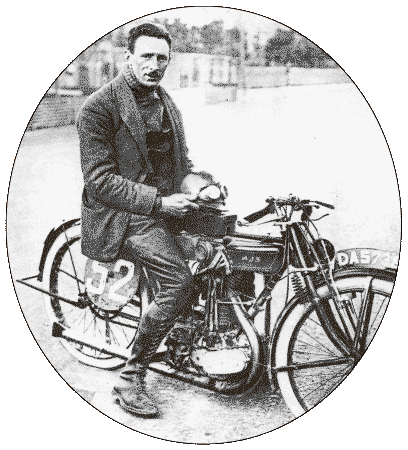
Eric Williams on his 2¾hp.
350c.c Junior T.T. winning machine. From 'Motorcycling', 22nd June, 1921. |
|

Howard Davies and his 1921 senior T.T. winning
machine. Courtesy of the late Jim Boulton. |
|
From ‘The Motor Cycle’ 23rd June,
1921
A Chat with the senior T.T. winner
A junior rider who won the senior event
Howard R. Davies, who came wonderfully near to
scoring a double success in this year’s T.T. races, is single, and
commemorates his twenty-sixth birthday next Monday, the 27th inst.
The 2¾hp. A.J.S. machine on which he won the senior
trophy at 54.5m.p.h. was not the same that he handled in the junior
event (when he finished second after puncturing on the second lap, and
subsequently retrieving his lost position), but the engine was
transferred to the senior frame. It is a wonderful engine too, measuring
74 x 81mm, 349c.c., for it laps Brooklands at 71m.p.h.
|
Davies told us that his machine, geared 4.8, 6, and
8 to 1, could attain72 or 73m.p.h. on favourable stretches of road. His
trip was uneventful
(so he said), for, apart from two stops at the
replenishment pits, he enjoyed a non-stop run.
No risks were taken at any time. He passed de la
Hay between Ballacraine Corner and Ballig Bridge on the first lap, and
thereafter had a fairly clear run until he began to overhaul the
tail-enders of the procession.
Mist on the mountain proved a slight handicap on
two circuits, for it necessitated removing the goggles. Asked if he knew
his position, Davies replied “No” and imagined Dance was leading him,
through cheering crowds indicated that he himself was among the leaders,
despite his limited engine capacity.
Davies’s mount ran most consistently throughout.
Second for four laps, he attained the lead at the end of the fifth lap,
and never lost it again; the only competitor to occupy the leading
position for two laps.
|
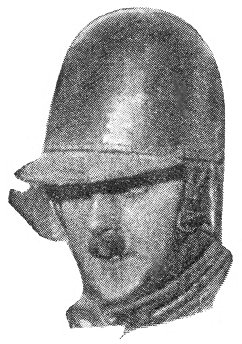 |
At Governor’s Bridge, nearing the end, he actually
had time to recognise a chum, who signalled that he was leading. Davies
was full of praise for his little mount, which never faltered
throughout, and, as he put it, “finished in perfect fettle.”
At this remark, he specially went out of his way to
introduce his mechanic, Bob Shakespeare, who has tended the A.J.S. T.T.
machine from the outset, and is responsible for Davies’s hill climbing
and speed mounts. The A.J.S., which weighed 202lb., he told us, steers
perfectly on the Manx course, which no doubt, accounted for the rider
finishing so fresh.
Noticing that the front rim was untouched, Davies
replied to our interrogation that he had never used the front brake
throughout. Howard Davies, magnificent rider though he is, was certainly
in luck last week, for he accepted a wager of 75 to 1 with S. L. Bailey
that he could not name winner of the double event; and won!
But for a slight dent in the back wheel rim, the
A.J.S. mount was as good as it started, and the Hutchinson tyres wore
remarkably well and remained almost unmarked. Other equipment included
Druid forks, Amac carburettor, T.B. magneto, K.L.G. plug, Renold block
chain on front, and roller chain at rear, A. K. knee grips, and he used
Castrol R lubricant and Pratt’s spirit.
It should be added that, apart from last week’s
achievement, Howard R. Davies, when riding a Sunbeam, tied for second
place with the late O. C. Godfrey in the 1914 event. After being taken
prisoner while flying over the German lines in 1917, Howard Davies,
subsequent to his repatriation, joined the Amac Company, and later
joined Messrs. A. J. Stevens and Company Limited, as competition
manager.
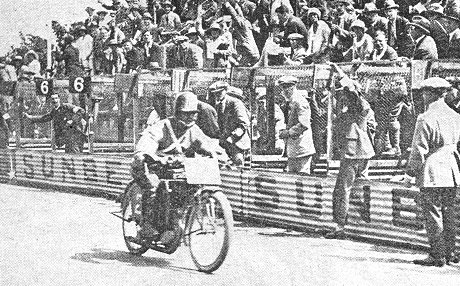
Crossing the finishing line. |
|
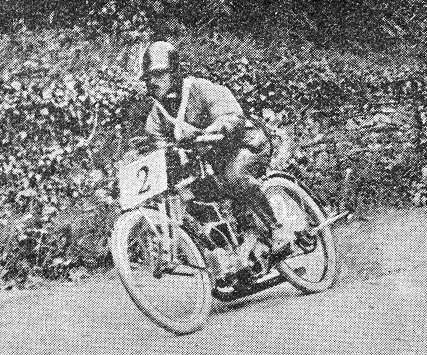 |
Howard Davies in action during the 1921 T.T.
From 'The
Motor Cycle', 23rd June, 1921. |
| Howard Davies and his machine that won the 1921
senior T.T. From 'The Motor Cycle', 23rd June, 1921. |
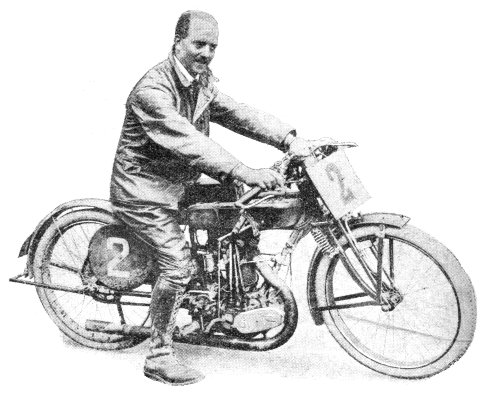 |
|
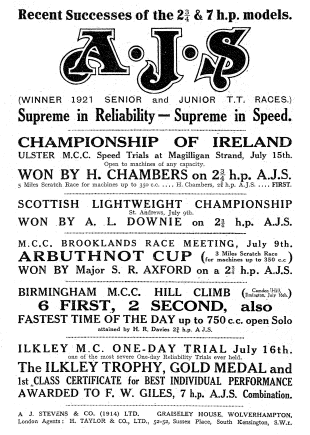
From 'The Motor Cycle', 4th August, 1921. |
Many other success
followed in trials and sporting events, and sales were greater
than ever.
Nearly 600 people were now employed on motorcycle
production, and yet more building work was undertaken at Graiseley
Hill.
The company decided to cash-in on its success in the
T.T. by launching two new 2¾hp. sporting
models in readiness for 1922, both based on the model 'B'.
The standard sporting machine,
the 'B1' had T.T. pattern handlebars and footboards, and the stripped
sporting machine, the 'B2' had no kickstarter or side valance to the front mudguard, but
included a lighter chaincase.
Both models were priced at £85. A new lightweight sidecar was
also introduced for the model 'B'. It included
a stormproof apron and sold for £25.
|
|
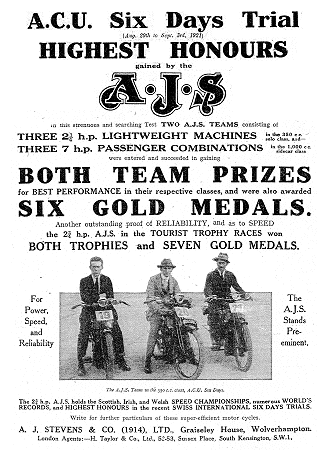
From 'The Motor Cycle', 15th September, 1921. |
|
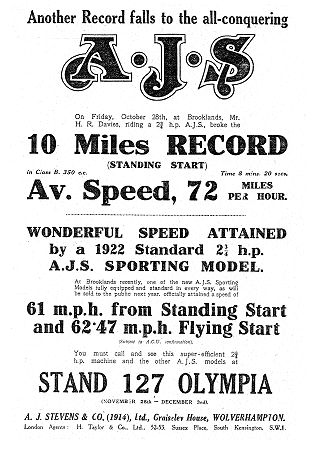
From 'The Motor Cycle', 10th November, 1921. |
|
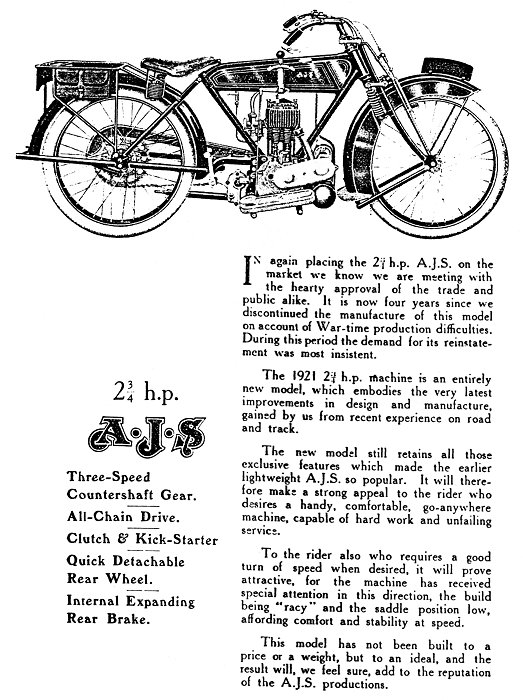
The image above and the one below
are from a 1921 catalogue. |
|
The 1922 junior T.T. took place on 30th May. The A.J.S.
entrants were Howard Davies, Frank Longman, H. F. Harris, Tom Sheard,
George Kelly, George Grinton, and Herbie Chambers. It was another
successful race for the A.J.S. team who achieved their 4th consecutive
win. Tom Sheard finished in first place at an average speed of
54.75m.p.h. George Grinton finished in 2nd place, and Herbie Chambers
finished in 14th place. The others did not finish.
There were three A.J.S. entries for the senior race,
Howard Davies, George Kelly, and Ossie Wade. Unfortunately Howard Davies
and George Kelly were forced to retire with mechanical problems. Ossie
Wade finished in 12th place, a disappointing race for the team.
|
| H. F. Harris and his 1922 junior T.T. machine.
Courtesy of the late Jim Boulton. |
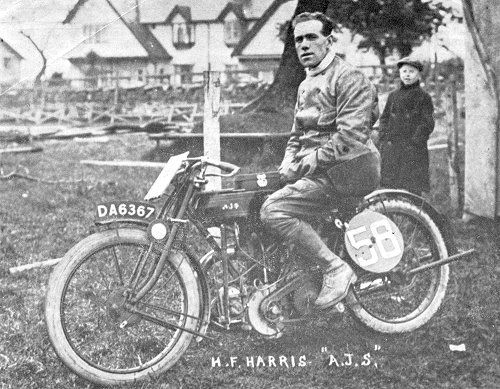 |
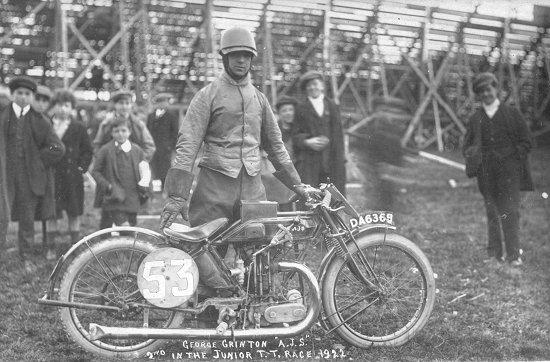 |
George Grinton and his 1922 junior T.T. machine.
Courtesy of the late Jim Boulton. |
|
The company decided to capitalise on their achievements
in the T.T. by launching a new machine, the '2¾hp.
three speed overhead valve T.T. model', soon being known as the 'Big
Port' It sold for £87 and was displayed at the Olympia Show.
Read about the
new 'Big Port' |
 |
The demand for sidecars had reached an all time high,
and so A.J.S. decided to look around for larger premises because of the
cramped conditions in Stewart Street. In 1922 the Briton Car Company
went into voluntary liquidation. Their Lower Walsall Street factory was
put up for sale, and Page & Sons, Estate Agents sold the Walsall Street
factory on October 3rd, 1922, for £7,000 to A.J.S. Before the end of the
year the sidecar business moved to Lower Walsall Street, and by the end
of 1924 the factory had been expanded to cover 150,000 square feet.
By the end of 1922 the Graiseley Hill factory covered
around 167,000 square feet, and sales remained high. In 1923 A.J.S.
began to manufacture wireless receivers in part of the Lower Walsall
Street factory, thanks to Harry Stevens, a keen radio enthusiast, and
radio amateur.
In 1923 Howard Davies left A.J.S. to work for
Hutchinson tyres, before starting his own company, HRD in 1924..
There were nine A.J.S. entries for the 1923 junior Isle
of Man T.T. held in June. The machines were ridden by Howard Davies, Tom Sheard, Jimmy Simpson, H. F. Harris, Frank Longman, Herbie Chambers,
Billy Hollowell, Charlie Hough, and J. Stirling. Only two of the riders
completed the course. H. F. Harris finished in second place at an
average speed of 55.16m.p.h., and Frank Longman finished in 6th place. |
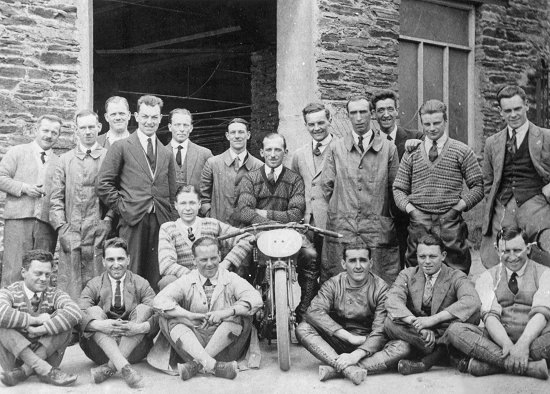
The 1923 A.J.S. T.T. team. Left to
right:
Back row: Joe
Stevens junior, Arthur Barnett, ?, ?, H. F. Harris, Bob Shakespeare,
J. W. Hollowell, Arthur Curran, G. Kelly, George Rowley, and Charlie Hough.
Middle row: Hanford Stevens (kneeling), Jimmy Simpson
(seated on motorcycle)
Front Row: Frank Longman, Clarrie Wise, N. Black, L.
R. Cohen, Arthur Cohen, and Ossie Wade. Courtesy of the late Jim
Boulton. |
Read about the
new machines
for the 1923 T.T. |
 |
|

H. F. Harris at the end of the first lap of the 1923
Junior T.T. Courtesy of the late Jim Boulton. |
| Four A.J.S. machines were entered for the senior race,
ridden by Howard Davies, H. F. Harris, Syd Crabtree, and Charlie Hough.
Again only two of the riders completed the course. They were Syd
Crabtree who finished in 17th place, and Charlie Hough who finished in
20th place. |
|
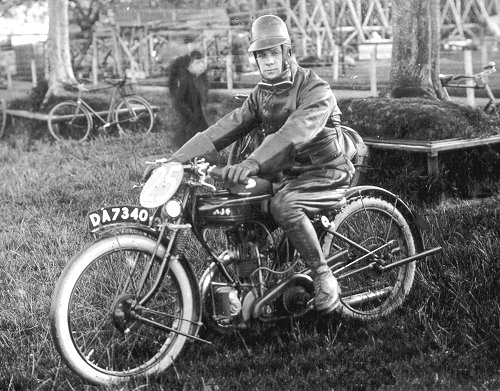
Charlie Hough. Courtesy of the late Jim
Boulton. |
|
On 24th June A.J.S. entered a team for the 350c.c.
French Grand Prix held at the Circuit de Touraine, near Tours. Frank
Longman finished in first position in the class, at an average speed of
56.4m.p.h. The team were again successful in September when Ernesto Gnesa won the Italian Grand Prix of Nations at Monza.
Seven models were displayed at the Olympia Show
including the top of the range 7hp. model 'D' de-luxe passenger
combination, which sold for £130. A cheaper 'no frills' version, the
'D1' sold for £95. The 'B' and 'B1' models were priced at £62, a
lighter sporting 'B5' sold for £52, and two sporting machines, the 'B3'
which replaced the T.T. sports model, and the 'B4' racing machine both
sold for £65. |
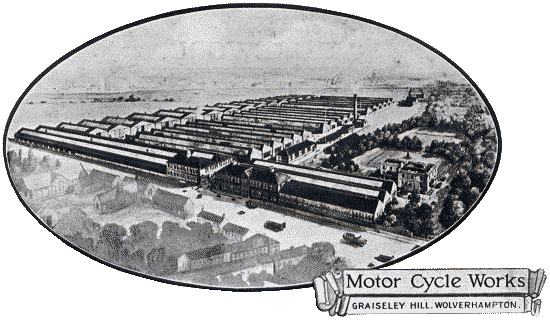
 |
 |
 |
Return to
Sidecars |
Return to
the Beginning |
Proceed to
Part Two |
|